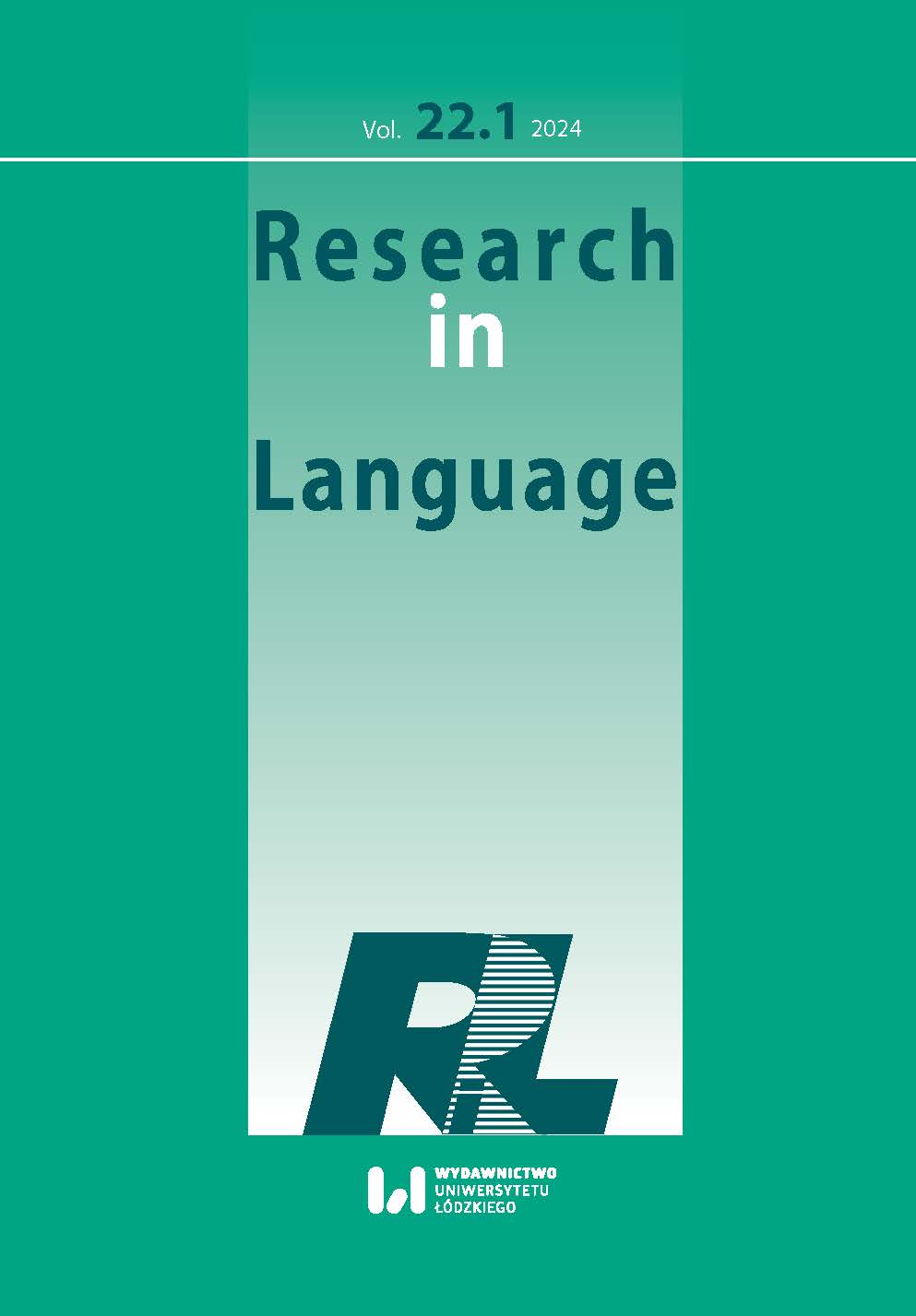The Frames of Romance Scamming
DOI:
https://doi.org/10.18778/1731-7533.22.1.01Keywords:
romance scamming, frame, script, format, love fraudAbstract
This paper studies love fraud or romance scamming as scripted communication within a commercial transaction frame. The main participants are the seller (fraudster), buyer (victim), goods (long-term romantic relationship), and money (paid by the victim). The data for this study were collected from 53 conversations between fraudsters and the author. The romance scamming frame was activated by language and lexical choices and geared to winning her trust. The process took place in stages or subframes that guided the victim towards the payment of a large sum of money. These subframes also corresponded to the different ‘subformats’ of an authentic script or ‘format’ used by romance scammers in West Africa.
References
Bilz, Alexander, Lynsay A. Shepherd, Graham I. Johnson 2023. Tainted Love: A systematic literature review of online romance scam research, Interacting with Computers, iwad048, https://doi.org/10.1093/iwc/iwad048
Google Scholar
DOI: https://doi.org/10.1093/iwc/iwad048
Camiciottoli, Belinda Crawford 2011. Ethics and Ethos in Financial Reporting: Analyzing persuasive language in earnings calls. Business Communication Quarterly 74 (3), 298–312. https://doi.org/10.1177/1080569911413810
Google Scholar
DOI: https://doi.org/10.1177/1080569911413810
Carter, Elisabeth 2021. Distort, Extort, Deceive and Exploit: Exploring the inner workings of a romance fraud. The British Journal of Criminology 61 (2), 283–302. https://doi.org/10.1093/bjc/azaa072
Google Scholar
DOI: https://doi.org/10.1093/bjc/azaa072
Carter, Elisabeth 2023. Confirm not Command: Examining fraudsters’ use of language to compel victim compliance in their own exploitation. The British Journal of Criminology 63, 1405–1422. https://doi.org/10.1093/bjc/azac098
Google Scholar
DOI: https://doi.org/10.1093/bjc/azac098
Chiluwa, Innocent. 2010. The pragmatics of hoax email business proposals. Linguistik Online 43 (3), 32–48. http://hdl.handle.net/11320/7505 https://doi.org/10.13092/lo.43.409
Google Scholar
DOI: https://doi.org/10.13092/lo.43.409
Coluccia Anna, Andrea Pozza, Fabio Ferretti, Fulvio Carabellese, Alessandra Masti, and Giocomo Gualtieri 2020. Online Romance Scams: Relational dynamics and psychological characteristics of the victims and scammers. A scoping review. Clinical Practice and Epidemiology in Mental Health 16: 24–35. doi: https://doi.org/10.2174/1745017902016010024
Google Scholar
DOI: https://doi.org/10.2174/1745017902016010024
Cross, Cassandra, and Rebecca Layt 2021. “I suspect that the pictures are stolen”: Romance fraud, identity crime, and responding to suspicions of inauthentic identities. Social Science Computer Review, 1–19. https://doi.org/10.1177/0894439321999311
Google Scholar
DOI: https://doi.org/10.1177/0894439321999311
Dreijers, Guntars, and Valda Rudziša 2020. Devices of Textual Illusion: Victimization in romance scam e-letters. Research in Language 18 (1), 1–13. https://doi.org/10.18778/1731-7533.18.1.01
Google Scholar
DOI: https://doi.org/10.18778/1731-7533.18.1.01
Fillmore, Charles 1976. Frame Semantics and the Nature of Language. Annals of the New York Academy of Sciences: Conference on the Origin and Development of Language and Speech 280: 20–32. https://doi.org/10.1111/j.1749-6632.1976.tb25467.x
Google Scholar
DOI: https://doi.org/10.1111/j.1749-6632.1976.tb25467.x
Fillmore, Charles 1982. Frame Semantics. In Linguistic Society of Korea (ed.), Linguistics in the Morning Calm, 111–138. Hanshin. http://brenocon.com/Fillmore%201982_2up.pdf
Google Scholar
Fillmore, Charles 1985. Frames and the Semantics of Understanding. Quaderni di Semántica 6 (2): 222–254. http://www.icsi.berkeley.edu/pubs/ai/framesand85.pdf
Google Scholar
Gillespie, Alisdair 2017. The Electronic Spanish Prisoner: Romance frauds on the Internet. The Journal of Criminal Law 81 (3), 217–231. https://doi.org/10.1lis77/0022018317702803
Google Scholar
DOI: https://doi.org/10.1177/0022018317702803
Kilgarriff, Adam., Vit Baisa, Jan Bušta, Milos Jakubíček, Vojtech Kovář, Jan Michelfeit, Pavel Rychlý, and Vit Suchomel 2014. The Sketch Engine: Ten years on. Lexicography 1; 7–36. https://doi.org/10.1007/s40607-014-0009-9
Google Scholar
DOI: https://doi.org/10.1007/s40607-014-0009-9
Koon, Tan H., and Yoong, David 2017. Preying on Lonely Hearts: A Systematic Deconstruction of an Internet Romance Scammer’s Online Lover Persona. Journal of Modern Languages 23 (1), 28–40.
Google Scholar
Levi, Michael, Alan Doig, Rajeev Gundur, David Wall, and Matthew Williams 2017. Cyberfraud and the Implications for Effective Risk-based Responses: Themes from UK research. Crime, Law and Social Change 67: 77–96. https://doi.org/10.1007/s10611-016-9648-0
Google Scholar
DOI: https://doi.org/10.1007/s10611-016-9648-0
Lee, Kam-Fong, Chan, Mei-Yuit, and Mohamad Ali, Afida 2023. Self and Desired Partner Descriptions in the Online Romance Scam: A linguistic analysis of scammer and general user profiles on online dating portals. Crime Prevention and Community Safety 25, 20–46. https://doi.org/10.1057/s41300-022-00169-7
Google Scholar
DOI: https://doi.org/10.1057/s41300-022-00169-7
Olajimbiti, Ezekiel Opeyemi 2018. Discourse Pattern, Contexts and Pragmatic Strategies of Selected Fraud Spam. The Journal of English Studies 21 (2): 53-63. https://doi.org/10.15290/cr.2018.21.2.05
Google Scholar
DOI: https://doi.org/10.15290/cr.2018.21.2.05
Schaffer, Deborah 2012. The Language of Scam Spams: Linguistic features of "Nigerian fraud" e-mails. Etc.: A Review of General Semantics 69 (2), 157–179.
Google Scholar
Schank, Roger, and Robert Abelson 1977. Scripts, Plans, Goals, and understanding. Lawrence Erlbaum. https://doi.org/10.4324/9780203781036
Google Scholar
DOI: https://doi.org/10.4324/9780203781036
Schuy, Roger W. 2016. The Language of Fraud Cases. Oxford University Press. https://doi.org/10.1093/acprof:oso/9780190270643.001.0001
Google Scholar
DOI: https://doi.org/10.1093/acprof:oso/9780190270643.001.0001
Searle, John R. 1969. Speech Acts. Cambridge: Cambridge University Press. https://doi.org/10.1017/CBO9781139173438
Google Scholar
DOI: https://doi.org/10.1017/CBO9781139173438
St. Clair, Robert S., Lichang Su, and Ana C. Thome Williams 2005. The Role of Social Script in Conceptual Blending. Journal of Intercultural Communication Studies XIV.
Google Scholar
Wang, Fangzhou, and Volkan Topalli 2022. Understanding Romance Scammers through the Lens of their Victims: Qualitative modeling of risk and protective factors in the online context. American Journal of Criminal Justice: 1-37. https://doi.org/10.1007/s12103-022-09706-4
Google Scholar
DOI: https://doi.org/10.1007/s12103-022-09706-4
Whitty, Monica. 2013a. Anatomy of the Online Dating Romance Scam. Security Journal 28 (4), 443–455. https://doi.org/10.1057/sj.2012.57
Google Scholar
DOI: https://doi.org/10.1057/sj.2012.57
Whitty, Monica 2013b. The Scammers Persuasive Techniques Model: Development of a stage model to explain the online dating romance scam. British Journal of Criminology 53 (4): 665–684. https://doi.org/10.1093/bjc/azt009
Google Scholar
DOI: https://doi.org/10.1093/bjc/azt009
Whitty, Monica 2018. Do You Love Me? Psychological Characteristics of Romance Scam Victims. Cyberpsychology, Behavior, and Social Networking 21 (2),105–109. https://doi.org/10.1089/cyber.2016.0729
Google Scholar
DOI: https://doi.org/10.1089/cyber.2016.0729
Downloads
Published
How to Cite
Issue
Section
License

This work is licensed under a Creative Commons Attribution-NonCommercial-NoDerivatives 4.0 International License.










